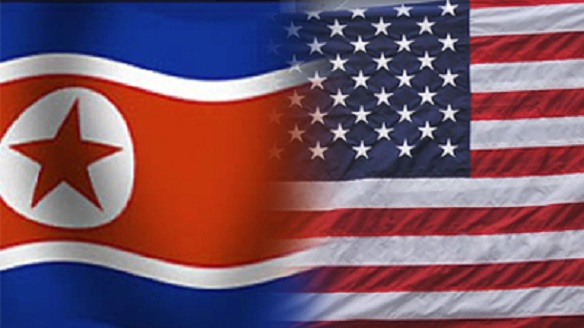
Massive joint US-South Korean military exercises began yesterday under conditions of high tension on the Korean Peninsula following North Korea’s fourth nuclear test in January and rocket launch last month. Under pressure from Washington, the UN Security Council last week imposed the most far-reaching sanctions to date on Pyongyang that will limit its mineral exports and compound the economic crisis wracking the unstable regime.
The annual war games—Key Resolve and Foal Eagle—have always been extremely provocative, mobilising the substantial resources of the South Korean military and US forces based in the country in a dress rehearsal for war with North Korea. The drills underway will be the largest-ever, involving 300,000 South Korean troops and 17,000 US personnel, backed by sophisticated armour and artillery, as well as air and sea power.
More significantly, however, this year’s exercises are based on a new joint operational plan—OPLAN 5015—which shifts the focus of a war against North Korea from a nominally defensive stance to an offensive one. According to details leaked in the media, the plan includes pre-emptive strikes on North Korea’s nuclear and missile sites, and “decapitation” raids by special forces units to assassinate North Korean figures, including leader Kim Jong Un, as the prelude to the seizure of the entire Korean Peninsula.
The South Korean newsagency Yonhap Post reported that the joint forces will also practice a new “4D” operational plan to detect, disrupt, destroy and defend against North Korea’s nuclear and missile arsenal.
OPLAN 5015, signed last November, is accompanied by Concept Plan (CONPLAN) 5029 that is focussed on sudden crises, such as a political collapse of the Pyongyang regime or an internal revolt in North Korea. The US and South Korean military have already formed a joint division specifically tasked with destroying North Korean weapons of mass destruction. In the event of war, the US, which maintains 28,500 troops in South Korea and is currently upgrading its bases, would assume full operational command of South Korea’s military forces.
In line with the aggressive measures outlined in OPLAN 5015, the Pentagon has sent nuclear-capable assets to take part in this year’s war games, including a nuclear attack submarine and reportedly a B-2 strategic bomber. The aircraft carrier John C. Stennis, fresh from a provocative intervention last week in the South China Sea directed against China, is also due to participate, along with its strike group of accompanying warships.
The US Forces Korea command relayed a formal note to Pyongyang about the dates of the annual exercises, absurdly insisting on “the non-provocative nature of this training.” The North Korean military responded with a bellicose statement declaring it had its own operational plan to liberate South Korea and strike the US mainland. It claimed to have deployed the “offensive means” to reduce “all bases of provocations… to seas in flames and ashes in a moment.”
Last week, North Korean leader Kim Jong Un ordered the country’s military to be ready to use its nuclear weapons at any time and declared that it was time “to convert our mode of military counteraction toward the enemies into a pre-emptive attack one.” This belligerent posturing and the efforts to amass a primitive nuclear arsenal are deeply reactionary. By its attempts to shore up popular support by whipping up nationalism and militarism, the faction-riven regime divides North Korean workers from their counterparts in South Korea, Asia and around the world, and plays directly into the hands of US imperialism.
Time and again over the past quarter century, Washington has deliberately exacerbated tensions on the Korean Peninsula as a means of putting pressure, not so much on North Korea, but on China. While the Obama administration pays lip service to negotiations over Pyongyang’s nuclear programs, it has ruled out any resumption of the six-party talks led by China unless North Korea makes major concessions in advance.
The US is exploiting the current tensions to justify its military build-up in North East Asia, including talks now underway to station a Terminal High Altitude Area Defence (THAAD) anti-ballistic missile system in South Korea—a key element in the Pentagon’s plans for nuclear war against China and also Russia. Moscow has condemned the “unprecedented” joint military exercises in South Korea for putting pressure on North Korea, as well as Pyongyang’s threatening statements.
The Obama administration’s actions on the Korean Peninsula are just one aspect of its “pivot to Asia”—an all-embracing diplomatic, economic and strategic offensive throughout the Indo-Pacific region aimed at subordinating China and ensuring US hegemony. The restructuring of US forces in South Korea is part of a far broader military build-up that envisages 60 percent of American air and naval power being stationed in Asia by 2020 as well as the strengthening of alliance, strategic partnerships and basing arrangements to encircle China.
Washington’s decision to wind up tension on the Korean Peninsula is utterly reckless. A minor accident and miscalculation along the Demilitarised Zone (DMZ) by either side has the potential to escalate what has always been a dangerous flashpoint into all-out war. Inflammatory rhetoric emanates not only from Pyongyang, but also from the right-wing government in Seoul headed by President Park Geun-hye, daughter of the US-backed dictator Park Chung-hee. The South Korean military yesterday stated: “We will respond resolutely and mercilessly if the North ignores our warning and attempts a provocation.”
US State Department spokesman John Kirby responded to the North Korean statement by declaring: “We certainly do take those kinds of threats seriously… and again call on Pyongyang to cease with the provocative rhetoric, to cease with the threats.” Analysts strongly doubt the ability of North Korea to miniaturise its crude nuclear weapons and mount them on a missile. For Washington to say it takes the empty threat seriously raises the question as to what it is planning. Is it preparing a military provocation of its own in line with the aggressive new OPLAN 5015?
The Pentagon is well aware that war on the Korean Peninsula could rapidly draw in other powers, including China and Russia. A Brookings Institution report published in January about the changing role of the US-South Korean military alliance warned that past strategies based on a war confined to the Korean Peninsula could be “inadequate or obsolete.” It cited the remarks of US Joint Chiefs of Staff chairman General Joseph Dunford in December that any conflict with North Korea would inevitably be “trans-regional, multi-domain and multifunctional.”
Translated from military-speak, Dunford’s comments signify that the Pentagon is preparing to fight a “trans-regional,” that is, a world war, in every domain—land, sea, air, space and cyberspace—using every available asset, including nuclear weapons.
Source: Global Research
Click below to hear this great interview with investigative researcher Bob Fletcher about everything from Planet X to CIA drug smuggling to underground cities for the elite!

